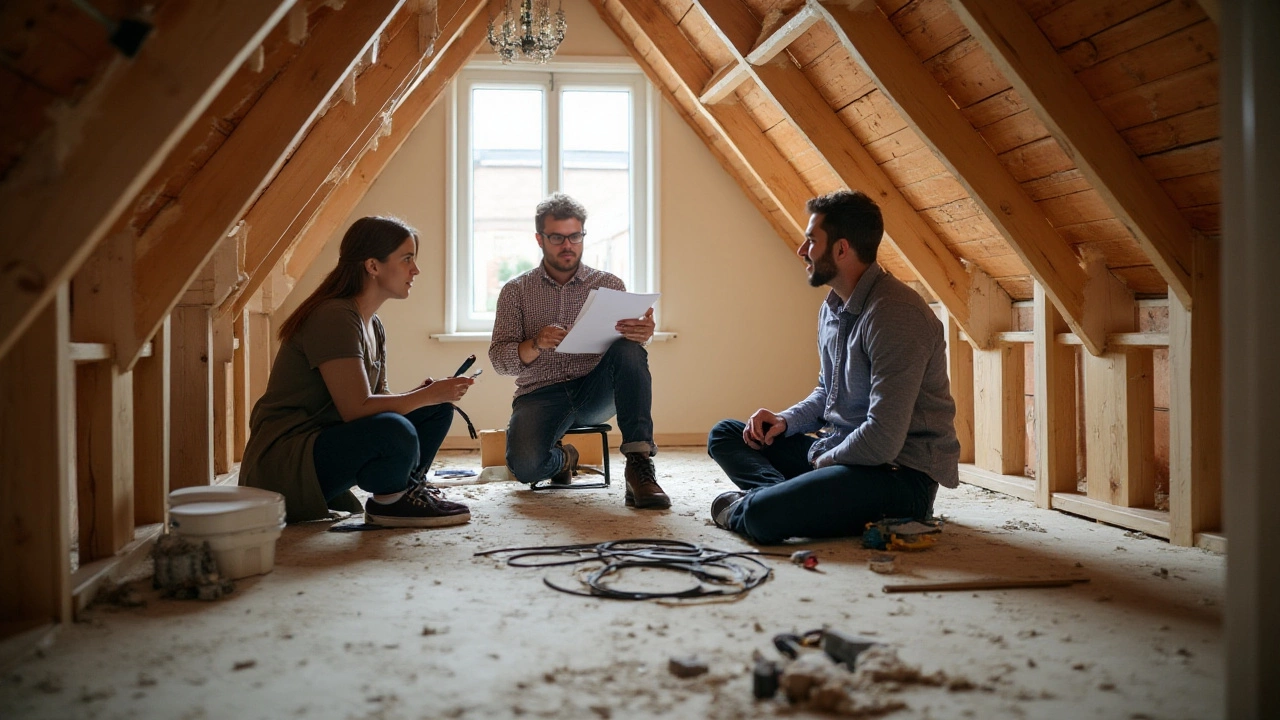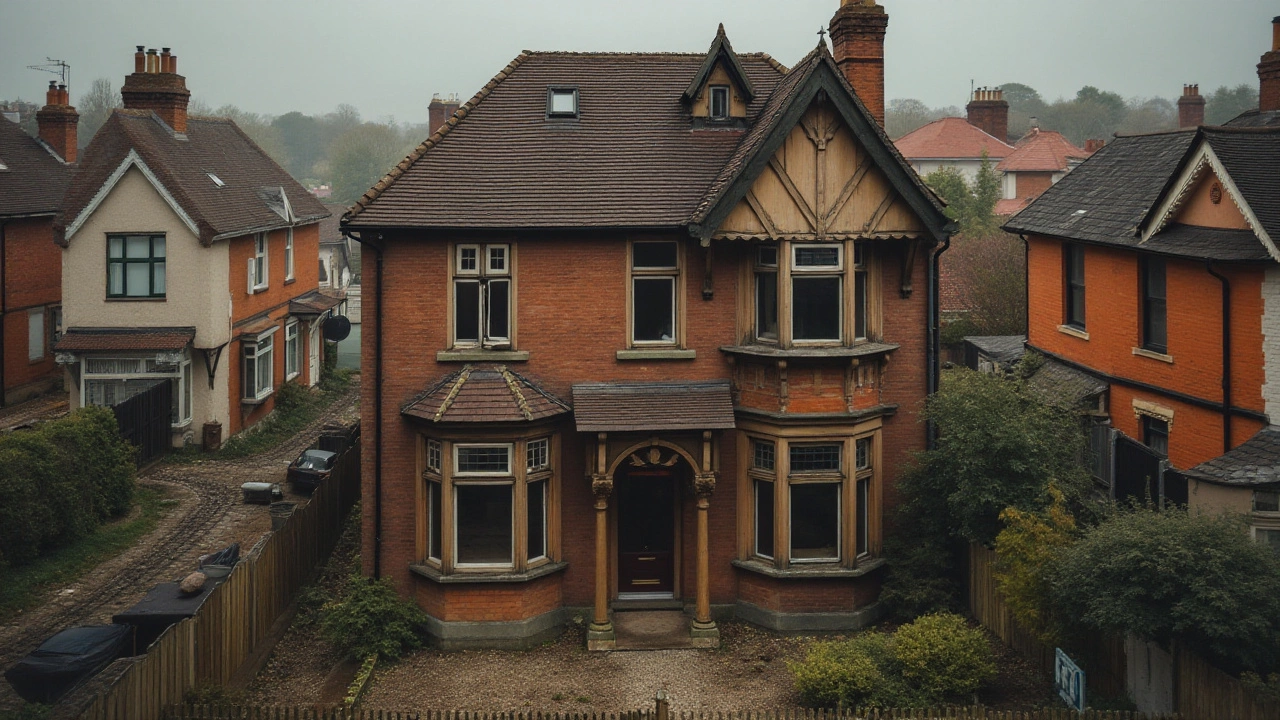Transforming an attic into a livable space has become a trendy way to maximize home potential. Yet, not every loft offers the promise of adding new life in the form of a cozy nook or an extra bedroom.
Before you embark on loft conversions, it's vital to recognize that some attics simply resist the change. Subtle structural quirks or stringent local regulations can be formidable barriers, making such transformations impractical or costly. In this article, we'll illuminate why some lofts just won't cooperate and offer tips to identify these non-convertible spaces before you even start drawing plans.
Discover the nuanced world of loft conversion possibilities and challenges as we break down what makes some lofts notoriously difficult, delving deep into the structural, legal, and financial aspects.
- Structural Challenges
- Roof Design Restrictions
- Neighborhood and Zoning Laws
- Financial Considerations
- Alternatives to Loft Conversions
Structural Challenges
Delving into the intricacies of loft conversions, one of the first hurdles you might encounter are the structural challenges that can turn your dream project into a logistical puzzle. These are not minor inconveniences but significant factors that could derail or even completely prevent a conversion. One particular aspect to consider is the existing roof structure which commonly consists of rafters or trusses. Rafters, which are beams forming the shape of the roof, offer more potential for conversion as there’s usually significant open space available between them. On the other hand, trussed roofs, which became popular in the late 20th century for their efficient use of materials, incorporate a web of supports that make it somewhat like a jigsaw puzzle to work around or remove without compromising the building's integrity.
To add another layer of complexity, the structural integrity of the building must support the additional weight that a fully developed loft space entails, including furniture and fixtures. This often means reinforcing the floor joists. Many older homes, particularly those over a century old, were built with joists intended to bear only the weight of the roof and ceiling materials. Introducing the burden of a new living area could necessitate expensive structural reinforcements. It’s not unusual to find that the floor joists need to be doubled or even tripled to meet modern building standards. An inspection by a structural engineer can save you from costly mistakes down the line, though their assessments may seem like an unwelcome roadblock at first.
Moreover, headroom is another critical consideration. According to building regulations, you’ll need a minimum of around 2.2 to 2.4 meters at the highest point of your loft to justify a conversion. This isn't always available, and gaining the necessary height may involve complex and costly changes like altering the roofline, lifting the structure, or even lowering the ceiling in the rooms below. Each of these options carries its own set of complications, often requiring significant planning permission hurdles and budget adjustments. The surprising thing that many potential converters fail to consider is ceiling load — capable engineers must confirm that your attic floor can indeed support the weight of people and furniture.
Finally, there's the reality of altered living spaces below the roof. Any conversion must consider how changes upstairs will affect life downstairs - possibly needing new ceiling supports or redistributing weight-bearing walls. An oft-overlooked factor is how windows and light sources might need reorganization, further complicating structural designs. A trusted architect, focused on renovation challenges, becomes an essential collaborator in balancing these elements with a comprehensive vision that maintains the integrity of the home. As the saying goes, "Planning is bringing the future into the present so that you can do something about it now," as noted by futurist Alan Lakein.
Roof Design Restrictions
When it comes to loft conversion, the design of your roof plays a pivotal role in determining whether you can proceed with your project. Some roofs exhibit traits that simply don't lend themselves to easy adaptation. Traditional houses commonly feature either pitched or flat roofs, and each presents its own unique set of challenges. Pitched roofs, especially those with a steep angle, can be quite accommodating in terms of space. However, the supporting framework often invades potential living areas, necessitating costly structural modifications. Flat roofs, on the other hand, offer limited headroom under the best of circumstances, often requiring a complete redesign to yield a functional space.
Another critical factor involves roofing materials and construction methods. Some houses, especially those built several decades ago, have roofs made from materials now deemed less safe or durable. Replacing these materials can be both a financial and logistical nightmare, eroding the benefits of even the most daring of renovation challenges. A historical home might come with additional restrictions, as architectural preservation guidelines will dictate what can and cannot be altered.
Moving on, consider the internal structure of the roof. The existence of a roof truss system can severely limit available space, complicating any envisioned layouts. Modern buildings often incorporate these structures for stability; however, they can occupy a good chunk of room, demanding inventive solutions to make any living space feasible. Here we can recall words from well-known architect Sarah Susanka, who pointed out, "The inside of a loft is much like the book’s cover — you won’t know its potential until you marry its internal story with your living needs."
The intricate dance between your loft's skeleton and your aspirations requires both creative vision and practical know-how. Don't expect the pages to lay flat.
Yet another aspect to consider is insulation, essential for any home improvement. A roof constructed with little regard for modern energy standards may not support the insulation required to turn an attic into a livable room, demanding further alterations that could spiral both time and budgets. Unfortunately, some roofs just won't accommodate these necessary adjustments, compromising the integrity and prospects of the conversion.
If your loft is located in a region with strict environmental laws or urban planning codes, you may find yourself facing another set of challenges, particularly if changes to the roofline are necessary for the conversion. Existing regulations often limit the ability to alter the height or silhouette of the structure, rendering some planned transformations impractical from a legal standpoint.

Neighborhood and Zoning Laws
When contemplating a loft conversion, it's easy to get caught up in the excitement of design and decor possibilities; however, stepping back and understanding neighborhood and zoning laws is critical. These regulations can deeply influence whether your attic transforms into that dream space or remains just a dusty storage area. Zoning laws are set by local governments to manage land use and they often vary significantly from one location to another. These laws dictate what can and cannot be done with your property. A crucial factor to consider is that even if your loft structurally supports conversion, zoning restrictions might deny you the opportunity. They'll dictate building heights, appearances, and it may even limit the number of conversions within a neighborhood to maintain a certain aesthetic or population density.
Homeowners often find themselves bewildered by these legal restrictions, with many projects being delayed or halted altogether once officials step in. Understanding these barriers before planning is more than beneficial; it’s necessary. A loft conversion not only alters your immediate living environment but can also impact your neighbors' properties with potential concerns over privacy, light obstruction, or aesthetics. For example, you might discover that your neighborhood prohibits roof alterations that exceed a certain height or impose specific roofing materials aimed at preserving historical authenticity. The implications are enormous and deserve careful consideration well ahead of time.
Neighborhood covenants often go unnoticed until they become stumbling blocks. These legal agreements can limit alterations to maintain harmony within subdivisions. While these rules can be restrictive, there's a balance of interests between individual desires and community standards. In a recent survey, approximately 54% of potential renovators admitted being unaware of neighborhood covenants affecting loft upgrades before planning. Gaining this insight could save time and a significant amount of resources. Prior to the commitment of conversion, consulting with local planners or solicitors familiar with these intricacies is wise.
Beyond legal parameters, there is a compelling need to liaison with your neighbors early on in the project to foster good relations and avoid later objections. Open conversations may reveal unspoken concerns that, if addressed early, smooth the path to successful conversion.
"A little advance research into zoning laws and open dialogue with neighbors often clears hurdles that can derail the best-laid loft conversion plans," notes Emily R. Siegel, a seasoned home development expert.While complex, navigating these laws with diligence ensures compliance and aligns your renovation dreams with local expectations. Always remember, while your joy may rise with a loft conversion, staying respectful of zoning laws keeps the peace.
Financial Considerations
Tackling a loft conversion can be quite the investment adventure. It’s easy to get carried away with dreams of sleek extra bedrooms or cozy attic spaces, but before you start tearing up floorboards, you need to grapple with the financial implications. Costs for a loft conversion can range broadly depending on numerous factors, including the size of the space, the type of conversion, and the materials used. On average, homeowners might spend anywhere from $20,000 to upwards of $70,000, and that’s a number not to be taken lightly.
When planning your budget, don't forget the hidden costs. Many first-time converters are surprised to find expenses creeping in from unexpected corners. Structural reinforcements, particularly with older homes, can add a significant dollar amount to your renovation bill. These are critical, however, ensuring your new space is both safe and up to code. It's also wise to factor in the local laws and the potential need for planning permissions and inspections, which can come with their own fees.
Then, there's the personal element—financing your project. It’s a good idea to tackle this with as much foresight as possible. Some homeowners choose to dip into savings, while others look to finance options like home equity loans or refinancing. As a rule of thumb, make sure you have a clear and realistic expense forecast and a good buffer for unplanned expenses. It’s not uncommon for loft conversion projects to go over budget, and having extra funds can alleviate the stress of financial strain during the remodeling process.
"A well-planned loft conversion not only boosts your home's living space but can also increase property value by up to 20%," notes experienced architect James Proctor. "Yet, it's essential to ensure your budget aligns with your home's potential for value appreciation in your specific area."
Moreover, consider that the quality of materials can impact both cost and durability. Opting for cheaper materials might save money initially, but in terms of long term value, investing in quality could be more economical. Conduct a cost-benefit analysis based on your intentions; whether you plan to sell soon after or enjoy the space yourself for years to come. Not every homeowner's aim is to recoup investment costs through resale, especially if the primary goal is to improve personal living space.
Finally, keep a close eye on possible tax implications. A loft conversion might affect the assessment of your property and, consequently, property taxes. Each region has specific rules that might impact your financial outlook. Consulting a financial advisor with experience in real estate can be beneficial. They can provide insight into special tax reliefs or incentives that might be available for renewable energy systems like solar panels, if you include these in your remodel.

Alternatives to Loft Conversions
When converting a loft seems impossible or impractical, there is no need for despair as there are numerous other ways to expand or enhance your living space. Understanding the constraints and exploring the options outside a typical loft conversion can save time, money, and frustration. Among the most viable alternatives is building a home extension, which can seamlessly integrate additional square footage into your existing structure. This approach allows for creative freedom in design and layout without the spatial restrictions often encountered in attics.
An extension doesn’t just add space; it adds value, often offering a significant return on investment. This option is highly customizable, allowing homeowners to match the extension's style to their current home's architecture. Alternatively, some individuals opt for a garden shed transformation into a home office or artsy studio. These external spaces often provide a quiet retreat from the hustle and bustle of daily life.
"Many homeowners find that expanding outwards with an extension offers more versatility than converting cramped attics," says Jonathan Fisher, a renowned architect known for adaptive home designs.
For those dealing with zoning or space limitations, reconfiguring interiors can be a clever strategy. This method involves evaluating existing spaces and optimizing them for better functionality. While inherently requiring a keen sense of spatial awareness, some choose to incorporate multifunctional furniture or open up floor plans to create the illusion of more space where none previously existed. Clever use of glass partitions and strategic lighting can further enhance this effect, breathing new life into old layouts without undergoing a full renovation.
Yet another innovative path is the use of basements. Frequently overlooked, basements can offer a wealth of underutilized real estate for various purposes, from additional living quarters to recreational rooms. Enhancing ventilation and natural light through light wells or sun tubes can transform a basement into a comfortable, vibrant space. This approach can sometimes even be more cost-effective than top-floor transformations, especially if the basement has already been partially finished or includes built-in utility access.
For those living in urban centers, loft apartment swaps offer a fresh start in a new setting. Capitalizing on city living amenities, many buildings are designed with modern amenities and spacious layouts that mimic the look of traditional homes. These options can deliver the same living area expansion benefits without the high costs associated with structural remodeling. From luxurious penthouse dwellings to quaint townhouse nooks, the opportunities are vast and varied, catering to diverse tastes and preferences.
Ultimately, when a loft conversion isn't feasible, exploring these alternative pathways to increase living space proves both engaging and practical. Each has unique advantages and considerations, and consulting with professionals can provide good insight into the best course of action tailored to specific circumstances.

Author
Damon Blackwood
I'm a seasoned consultant in the services industry, focusing primarily on project management and operational efficiency. I have a passion for writing about construction trends, exploring innovative techniques, and the impact of technology on traditional building practices. My work involves collaborating with construction firms to optimize their operations, ensuring they meet the industry's evolving demands. Through my writing, I aim to educate and inspire professionals in the construction field, sharing valuable insights and practical advice to enhance their projects.